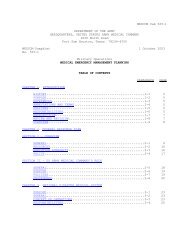(MCD) Guidelines
(MCD) Guidelines
(MCD) Guidelines
You also want an ePaper? Increase the reach of your titles
YUMPU automatically turns print PDFs into web optimized ePapers that Google loves.
<strong>Guidelines</strong> for Military Mass Casualty Decontamination Operations<br />
During a Domestic HAZMAT/Weapon of Mass Destruction Incident<br />
the contaminant determines what protective equipment is worn, how casualties are<br />
extracted, and most importantly, which <strong>MCD</strong> techniques are used to decontaminate<br />
casualties.<br />
Conducting a preliminary hazard assessment aids in the selection of the most<br />
appropriate detection device for positively identify the contaminant. Symptomology<br />
reports, the speed by which symptoms begin to appear, casualty interviews, and<br />
scene assessments provide information that can help include or exclude possible<br />
contaminants.<br />
This equipment is also used to ensure decontamination is as complete as possible<br />
throughout the <strong>MCD</strong> process. There are various points when monitoring equipment<br />
is used within the decontamination corridor to determine the thoroughness of<br />
decontamination, as described in Section 8.1.11.<br />
Detection devices that are generally available to military and civilian responders<br />
detect chemical, biological, and radiological agents. 40 There are many different types<br />
of detectors that identify and/or measure the amount of a chemical present.<br />
Biological agents are most commonly analyzed in the field using enzyme<br />
immunoassay tests. Radiation is naturally occurring and is everywhere. Radiation<br />
detectors detect and measure the presence of radiation. Some detectors operate by<br />
simply turning the instrument on to detect radiation, while others use probes to<br />
detect and measure radiation. 2,15<br />
Some detection devices can differentiate between compounds but not quantify the<br />
amount. Others can report a quantity of agent but not determine what or how many<br />
agents are present. 41 Some detectors are best designed for vapors, but others<br />
require a solid or liquid sample. Some respond almost immediately, but others can<br />
take more than 20 minutes.<br />
Consider all of these factors when selecting the combination of equipment to use in<br />
a response operation. Additional factors for the selection of monitoring equipment<br />
are listed in Table 1. 41<br />
Table 1: Factors for the Selection of Monitoring Equipment.<br />
Selection Factors for Monitoring Equipment<br />
Features Description<br />
Agents Detected This describes the chemical, biological, or radiological material the device<br />
can detect.<br />
Sensitivity This describes the minimum detection limit of the device.<br />
Response Time This is defined as the amount of time required for the instrument to collect,<br />
analyze, and provide feedback on a sample.<br />
Resistance to Sometimes, a compound can cause a detector to alarm when it should not,<br />
Interferents<br />
which is a false positive. Or, a compound can prevent a detector from<br />
alarming when it should, which is a false negative. Such a compound is<br />
considered to be an interferent. This describes how well a device can<br />
differentiate an interferent from a true agent of interest.<br />
14 Original



